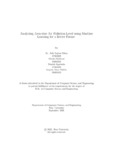| dc.contributor.advisor | Islam, Md. Saiful | |
| dc.contributor.author | Sihan, Sk. Atik Tajwar | |
| dc.contributor.author | Rabbani, Maisha | |
| dc.contributor.author | Agarwala, Manish | |
| dc.contributor.author | Maliha, Sanjida Alam | |
| dc.date.accessioned | 2021-12-26T06:26:03Z | |
| dc.date.available | 2021-12-26T06:26:03Z | |
| dc.date.copyright | 2021 | |
| dc.date.issued | 2021-09 | |
| dc.identifier.other | ID 17301109 | |
| dc.identifier.other | ID 19201123 | |
| dc.identifier.other | ID 17301120 | |
| dc.identifier.other | ID 20301453 | |
| dc.identifier.uri | http://hdl.handle.net/10361/15761 | |
| dc.description | This thesis is submitted in partial fulfillment of the requirements for the degree of Bachelor of Science in Computer Science and Engineering, 2021. | en_US |
| dc.description | Cataloged from PDF version of thesis. | |
| dc.description | Includes bibliographical references (pages 23-24). | |
| dc.description.abstract | Environment consists of nature and surroundings where all living beings co-exist.
Harming the environment will in turn harm all living and non-living things alike.
One of the major concerns of environment pollution is air pollution, which affects
human health, vegetation and aquatic life. However, in developing countries like
Bangladesh, air pollution is not considered a major issue. It is mostly caused by
the release of harmful gases into the atmosphere. Our goal is to develop a model
using machine learning which will determine the level of air pollution in a particular
area, detect elements which cause air pollution and predict future pollution level.
Algorithms such as Linear Regression, Facebook Prophet, RNN and ARIMA models
have been used throughout the course of this study. From RNN we have used LSTM
model for prediction which uses special units as well as standard units. With these
models we have predicted the pollutant emission rate for analyzing the area-wise
pollution rate. We have used different type of algorithms to successfully get the
optimum result and to get the fi nal result with less error. This will help to analyze
the overall air pollution condition which will help to take necessary steps accordingly. | en_US |
| dc.description.statementofresponsibility | Sk. Atik Tajwar Sihan | |
| dc.description.statementofresponsibility | Maisha Rabbani | |
| dc.description.statementofresponsibility | Manish Agarwala | |
| dc.description.statementofresponsibility | Sanjida Alam Maliha | |
| dc.format.extent | 24 pages | |
| dc.language.iso | en | en_US |
| dc.publisher | Brac University | en_US |
| dc.rights | Brac University theses are protected by copyright. They may be viewed from this source for any purpose, but reproduction or distribution in any format is prohibited without written permission. | |
| dc.subject | Environment | en_US |
| dc.subject | Air pollution | en_US |
| dc.subject | Pollutants | en_US |
| dc.subject | Linear regression | en_US |
| dc.subject | Facebook Prophet | en_US |
| dc.subject | RNN | en_US |
| dc.subject | LSTM | en_US |
| dc.subject | ARIMA | en_US |
| dc.subject.lcsh | Machine learning | |
| dc.title | Analyzing area-wise air pollution level using machine learning for a better future | en_US |
| dc.type | Thesis | en_US |
| dc.contributor.department | Department of Computer Science and Engineering, Brac University | |
| dc.description.degree | B. Computer Science | |

